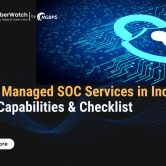The Insurance Regulatory and Development Authority of India (IRDAI) recently imposed a penalty of ₹3.39 crore on Star Health and Allied Insurance for multiple regulatory violations. While the headline points to operational and compliance lapses, there’s a deeper concern beneath the surface: cybersecurity vulnerabilities.
In today’s digital-first insurance ecosystem—where sensitive customer data, digital claim settlements, online onboarding, and third-party integrations dominate—the Star Health case serves as a red flag for every insurer. The penalty highlights the urgent need for a proactive, hyperautomated cybersecurity approach, especially in light of evolving IRDAI cybersecurity guidelines.
Let’s decode the implications of this penalty and explore how a Hyperautomated Autonomous Security Operations Center (SOC) can help insurance companies stay compliant, resilient, and protected.
What Happened? A Quick Recap of the ₹3.39 Cr Penalty on Star Health
IRDAI penalized Star Health primarily due to:
- Delays in claim settlements
- Failure to maintain proper records
- Non-compliance with prescribed turnaround times
- Gaps in audit and process oversight
While these appear operational, such failings often originate or escalate due to poor IT security posture, inadequate data governance, and lack of automation. These are precisely the areas modern cybercriminals exploit—leading to data breaches, fraud, and compliance failures.
The Hidden Cyber Risks Behind Regulatory Penalties
1. Data Breaches & Leakage
Poor record maintenance and delay in processing often stem from outdated or unsecured systems. If insurers are not using real-time monitoring or endpoint detection, attackers can infiltrate systems and exfiltrate sensitive data unnoticed.
2. Compliance Failures
IRDAI mandates regular risk assessments, incident reporting, and data protection policies. Manual compliance processes are error-prone. Without a centralized SOC, it becomes difficult to detect violations in real time.
3. Fraud & Insider Threats
Lack of monitoring of internal systems allows rogue insiders or external actors to manipulate data, delay claims intentionally, or exploit customer information—all of which increase regulatory and reputational risks.
IRDAI’s Cybersecurity Guidelines: What Insurers Must Follow
IRDAI has issued clear cybersecurity directives, including:
- Robust IT Governance Framework
- Data Localization & Protection Policies
- Security Operations Center (SOC) Implementation
- Continuous Risk Monitoring & Incident Response
- Vulnerability Assessment & Penetration Testing (VAPT)
- Third-party Risk Management
Failure to adhere to these could result in heavy penalties, license restrictions, or customer lawsuits.
Enter Hyperautomated Autonomous SOC – The Future of Cyber Defense in Insurance
What is a Hyperautomated SOC?
A Hyperautomated Autonomous SOC uses AI, machine learning, behavioral analytics, DFIR and DSLLM (Domain Specific Large Language Model) to detect, respond, and neutralize threats in real time—without human delay.
At AiCyberWatch, our Hyperautomated SOC-as-a-Service goes beyond traditional monitoring. It ensures:
✅ 24/7 threat detection & response
✅ Autonomous incident remediation
✅ Continuous compliance mapping with IRDAI & RBI norms
✅ Real-time visibility across cloud, endpoints, networks
✅ Attack surface monitoring across third-party integrations
✅ Zero-trust based access and insider threat detection
How Hyperautomation SOC Helps Insurers Stay IRDAI Compliant
| IRDAI Cybersecurity Mandate | How Hyperautomated SOC Supports It |
| Continuous Monitoring & Incident Detection | AI-powered alerts with zero false positives, real-time forensic trails |
| Incident Response Plan (IRP) | Automated playbooks for instant isolation & remediation |
| Secure Configuration of IT Assets | Continuous configuration audits & drift detection |
| VAPT and Risk Assessment | Automated vulnerability scans with prioritized remediation |
| Third-Party Risk Oversight | Deep visibility into APIs, integrations, and partner environments |
| Regular Audit & Reporting | Auto-generated, IRDAI-aligned compliance reports |
Real-World Scenarios Where Autonomous SOC Makes a Difference
Preventing Unauthorized Access
Imagine a misconfigured claim management portal allowing access to unverified users. The autonomous SOC immediately flags, isolates, and reports the misconfiguration before exploitation.
Detecting Insider Fraud
An internal employee tries to alter claim data for personal gain. Behavioral AI identifies abnormal access patterns and blocks the activity within milliseconds.
Stopping Ransomware Attacks
A phishing email targets the underwriting team. Autonomous SOC identifies the payload, cuts off the endpoint, and neutralizes the threat—before encryption begins.
Don’t Wait for a ₹3.39 Cr Wake-up Call
The Star Health penalty is not an isolated case—it’s a symptom of growing gaps between digital growth and cybersecurity maturity in the insurance industry. As IRDAI tightens the noose on compliance, insurers must not only comply on paper but demonstrate resilience in practice.
A Hyperautomated SOC is not a luxury—it’s a regulatory, operational, and reputational necessity.
How AiCyberWatch Can Help
As a trusted Managed Security Services Provider and Authorized Partner of Imperum.io, AiCyberWatch enables insurers to:
✅ Deploy Hyperautomated SOC with minimal setup
✅ Achieve 24/7 IRDAI-aligned threat detection & compliance
✅ Eliminate alert fatigue with autonomous response
✅ Conduct regular VAPT and security audits
✅ Ensure secure onboarding, claims, and customer data protection
📢 Ready to future-proof your cybersecurity posture?
Connect with AiCyberWatch today to deploy your Autonomous SOC and stay one step ahead of compliance failures and cyber risks.




